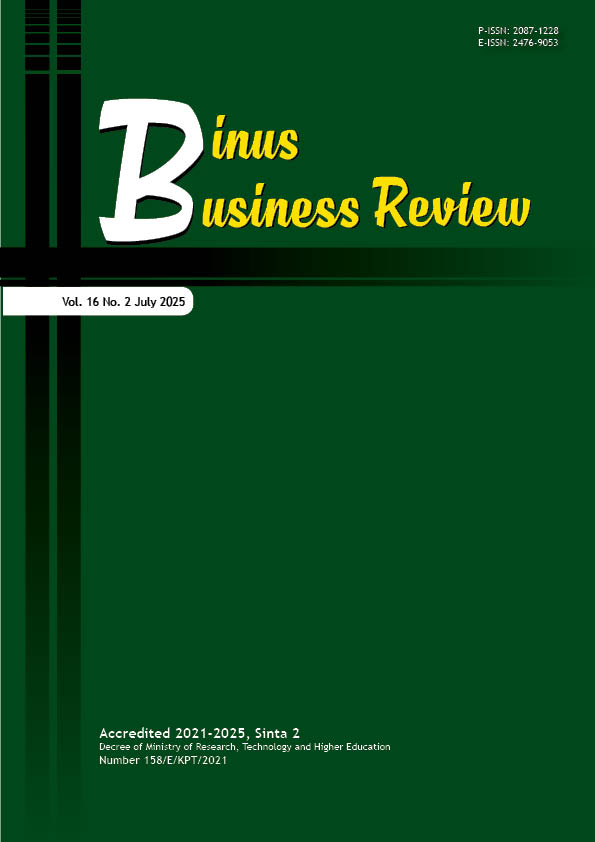Empowering Green Innovation: How CEO and Firm-Level Factors Shape Sustainable Business Growth in Indonesia
DOI:
https://doi.org/10.21512/bbr.v16i2.13275Keywords:
green product innovation, CEO characteristics, financial performance, firm age, sustainable business growthAbstract
Climate change, driven by global warming, is a critical global issue affecting air quality and the environment. In response, many companies are adopting sustainable practices such as green product innovation. The research examined the impact of CEO and firm-level factors on financial performance through green product innovation in the raw material-producing sector listed on the Indonesia Stock Exchange from 2020 to 2022. The research focused on five key variables: CEO education, gender, experience, firm size, and firm age, analyzing their effects on the adoption of green product innovation and subsequent impact on company growth and profitability. Secondary data were collected from the company's annual and sustainability reports using purposive sampling, resulting in a sample of 81 companies over three years. Data were analyzed using multiple linear regression and mediation tests. The results show that CEO gender and experience have a significant positive effect on green product innovation, while CEO education does not show a significant effect. Additionally, larger and older companies are more likely to implement green innovations due to their established resources and capacities. Green product innovation positively influences financial performance, reflected in increased sales and operational efficiency. These results suggest that both CEO and firm-level factors play a key role in driving sustainability initiatives that contribute to long-term business growth. The research provides valuable insights for companies aiming to enhance their sustainability strategies and for policymakers encouraging green innovation. Managerial implications point to the importance of fostering experienced leadership and leveraging company resources to support environmentally responsible innovation.
References
Abimanyu, I. W. P. S., & Nugraha, A. P. (2024). Latar belakang pendidikan CEO, pengalaman CEO dan kinerja perusahaan (Studi pada perusahaan yang terdaftar di Indeks LQ45, Indonesia). Ekonomis: Journal of Economics and Business, 8(1), 343–348. https://doi.org/10.33087/ekonomis.v8i1.1402
Amalia, E. (2023). Analisis pengaruh pengungkapan inovasi hijau terhadap profitabilitas pada perusahaan nonkeuangan. ABIS: Accounting and Business Information Systems Journal, 11(3), 285–309. https://doi.org/10.22146/abis.v11i3.85680
Asad, M., Aledeinat, M., Majali, T., Almajali, D. A., & Shrafat, F. D. (2024). Mediating role of green innovation and moderating role of resource acquisition with firm age between green entrepreneurial orientation and performance of entrepreneurial firms. Cogent Business & Management, 11(1), 1–17. https://doi.org/10.1080/23311975.2023.2291850
Brahma, S., Nwafor, C., & Boateng, A. (2021). Board gender diversity and firm performance: The UK evidence. International Journal of Finance & Economics, 26(4), 5704–5719. https://doi.org/10.1002/ijfe.2089
Cahyaningtyas, S. R., Isnaini, Z., & Ramadhani, R. S. (2022). Green corporate social responsibility: Green Innovation Dan Nilai Perusahaan. Jurnal Aplikasi Akuntansi, 6(2), 87–108. https://doi.org/10.29303/jaa.v6i2.137
Chen, L. H., Zhang, L., & Wang, H. Q. (2022). Research on the impact of government subsidies on green innovation of new energy enterprises. Friends of Accounting, 11, 150–157.
Chen, Y. S., & Chang, K. C. (2013). The nonlinear effect of green innovation on the corporate competitive advantage. Quality & Quantity, 47, 271–286. https://doi.org/10.1007/s11135-011-9518-x
Du, Y., & Wang, H. (2022). Green innovation sustainability: How green market orientation and absorptive capacity matter? Sustainability, 14(13), 1–20. https://doi.org/10.3390/su14138192
Fabiola, V. P., & Khusnah, H. (2022). Pengaruh green innovation dan kinerja keuangan pada competitive advantage dan nilai perusahaan tahun 2015-2020. Media Mahardhika, 20(2), 295–304. https://doi.org/10.29062/mahardika.v20i2.346
Farza, K., Ftiti, Z., Hlioui, Z., Louhichi, W., & Omri, A. (2021). Does it pay to go green? The environmental innovation effect on corporate financial performance. Journal of Environmental Management, 300. https://doi.org/10.1016/j.jenvman.2021.113695
Filipović, S., Lior, N., & Radovanović, M. (2022). The green deal – just transition and sustainable development goals Nexus. Renewable and Sustainable Energy Reviews, 168. https://doi.org/10.1016/j.rser.2022.112759
Ghardallou, W. (2022). Corporate sustainability and firm performance: The moderating role of CEO education and tenure. Sustainability, 14(6), 1–16. https://doi.org/10.3390/su14063513
Ghozali, I. (2018). Aplikasi analisis multivariate dengan program IBM SPSS 25 (9th ed.). Badan Penerbit Universitas Diponegoro.
He, X., & Jiang, S. (2019). Does gender diversity matter for green innovation? Business Strategy and the Environment, 28(7), 1341–1356. https://doi.org/10.1002/bse.2319
Heise, L., Greene, M. E., Opper, N., Stavropoulou, M., Harper, C., Nascimento, M., ... & Gupta, G. R. (2019). Gender inequality and restrictive gender norms: Framing the challenges to health. The Lancet, 393(10189), 2440–2454. https://doi.org/10.1016/S0140-6736(19)30652-X
Huang, C. J., Wan Ahmad, W. N., & Saad, R. A. J. (2025). Can female CEOs improve corporate environmental, social and governance performance? Gender in Management, 40(1), 91–113. https://doi.org/10.1108/GM-11-2023-0450
Huang, M., Li, M., & Liao, Z. (2021). Do politically connected CEOs promote Chinese listed industrial firms’ green innovation? The mediating role of external governance environments. Journal of Cleaner Production, 278. https://doi.org/10.1016/j.jclepro.2020.123634
IQAIR. (2022). 2022 world air quality report. https://www.scribd.com/document/631509039/2022-World-Air-Quality-Report-US-1?
Irham, M. F., Zakaria, A., & Utaminingtyas, T. H. (2023). Pengaruh karakteristik perusahaan, leverage, dan opini audit terhadap profitabilitas pada perusahaan sub sektor manufaktur selama masa pandemi. Transekonomika: Akuntansi, Bisnis dan Keuangan, 3(3), 586–600. https://doi.org/10.55047/transekonomika.v3i3.440
Irwhantoko, & Basuki. (2016). Carbon emission disclosure: Studi pada perusahaan manufaktur Indonesia. Jurnal Akuntansi dan Keuangan, 18(2), 92–104. https://doi.org/10.9744/jak.18.2.92-104
Istan, M., Husainah, N., Murniyanto, Suganda, A. D., Siswanti, I., & Fahlevi, M. (2021). The effects of production and operational costs, capital structure and company growth on the profitability: Evidence from manufacturing industry. Accounting, 7, 1725–1730. https://doi.org/10.5267/j.ac.2021.4.025
Kallias, A., Kallias, K., Tsalkamas, I., & Zhang, S. (2023). One size does not fit all: The conditional role of CEO education on IPO performance. Journal of Business Research, 157, 1–14. https://doi.org/10.1016/j.jbusres.2022.113560
Khan, S. J., Dhir, A., Parida, V., & Papa, A. (2021). Past, present, and future of green product innovation. Business Strategy and the Environment, 30(8), 4081–4106. https://doi.org/10.1002/bse.2858
Kieso, D. E., Weygandt, J. J., & Warfield, T. D. (2020). Intermediate accounting: IFRS edition (4th ed.). John Wiley & sons.
Kieso, D. E., Weygandt, J. J., Warfield, T. D., Wiecek, I. M., & McConomy, B. J. (2019). Intermediate accounting, volume 1. John Wiley & Sons.
Lé, M., & Vinas, F. (2024). Firm listing status, firm size, and the financing of investment. The Review of Corporate Finance Studies, 13(3), 818–857. https://doi.org/10.1093/rcfs/cfac038
Leyva-de la Hiz, D. I., & Bolívar-Ramos, M. T. (2022). The inverted U relationship between green innovative activities and firms’ market-based performance: The impact of firm age. Technovation, 110. https://doi.org/10.1016/j.technovation.2021.102372
Lin, W. L., Cheah, J. H., Azali, M., Ho, J. A., & Yip, N. (2019). Does firm size matter? Evidence on the impact of the green innovation strategy on corporate financial performance in the automotive sector. Journal of Cleaner Production, 229, 974–988. https://doi.org/10.1016/j.jclepro.2019.04.214
Matemilola, B. T., Kijkasiwat, P., & Liew, C. Y. (2025). The moderating effect of firm age on capital structure choices: Evidence from emerging markets. Journal of Industrial and Business Economics, 52, 177–199. https://doi.org/10.1007/s40812-024-00299-z
Maziriri, E. T., & Maramura, T. C. (2022). Green innovation in SMEs: The impact of green product and process innovation on achieving sustainable competitive advantage and improved business performance. Academy of Entrepreneurship Journal, 28(3), 1–15.
Meilani, S. E. R., & Sukmawati, R. A. (2023). Peran green innovation dan environmental responsibility terhadap nilai perusahaan sektor manufaktur di Indonesia. Jurnal Riset Akuntansi dan Keuangan, 11(3), 605–620. https://doi.org/10.17509/jrak.v11i3.60311
Najib, M., Fahma, F., Abror, & Suhartanto, D. (2022). Organizational capability, market perspective, and green innovation adoption: Insight from Indonesian food processing small and medium-sized enterprises. Journal of Small Business Strategy, 32(2), 51–66. https://doi.org/10.53703/001c.32293
OECD. (2021, January 12). OECD science, technology and innovation outlook 2021. https://doi.org/10.1787/75f79015-en
Otoritas Jasa Keuangan. (2017, July 27). Penerapan keuangan berkelanjutan bagi lembaga jasa keuangan, emiten, dan perusahaan publik. https://ojk.go.id/id/regulasi/Pages/Penerapan-Keuangan-Berkelanjutan-bagi-Lembaga-Jasa-Keuangan,-Emiten,-dan-Perusahaan-Publik.aspx
Pinto, I. F., Borges, A. P., Vieira, E., Vieira, B. M., Monteiro, M., & Castilho, D. (2023). Green marketing, environmental awareness, and innovation as factors for the purchase of green products. In R. Masengu, S. Bigirimana, O. Chiwaridzo, R. Bensson, & C. Blossom (Eds.), Sustainable marketing, branding, and reputation management: Strategies for a greener future (pp. 178–194). IGI Global Scientific Publishing. https://doi.org/10.4018/979-8-3693-0019-0.ch009
Rahman, M. (2023). The virtuous circle between green product innovation and performance: The role of financial constraint and corporate brand. Journal of Business Research, 154. https://doi.org/10.1016/j.jbusres.2022.09.001
Saha, R. (2023). The impact of board-level female directors on firm performance: Evidence from India. Equality, Diversity and Inclusion, 42(8), 945–967. https://doi.org/10.1108/EDI-07-2022-0172
Savitri, R. J., Purwohedi, U., & Zakaria, A. (2023). Pengaruh firm growth dan total asset turnover terhadap kinerja keuangan. Jurnal Akuntansi, Perpajakan dan Auditing, 4(3), 655–670. https://doi.org/10.21009/japa.0403.03
Setiawan, M. R., Susanti, N., & Nugraha, N. M. (2021). Pengaruh struktur modal, perputaran modal kerja, dan ukuran perusahaan terhadap nilai perusahaan. Owner: Riset dan Jurnal Akuntansi, 5(1), 208–218. https://doi.org/10.33395/owner.v5i1.383
Sulaiman, M. A. B. A. (2025). Green product innovation as a mediator between green market orientation and sustainable performance of SMEs. Sustainability, 17(4), 1–17. https://doi.org/10.3390/su17041628
Tonay, C., & Murwaningsari, E. (2022). Pengaruh green innovation dan green intellectual capital terhadap nilai perusahaan dengan ukuran perusahaan sebagai moderasi. Jurnal Bisnis dan Akuntansi, 24(2), 283–294.
Triansyah, M. B., Adam, M., & Wahyudi, T. (2020). Carbon emission disclosure in Indonesia’s manufacturing companies. Accounting and Finance, 3(89), 148–154. https://doi.org/10.33146/2307-9878-2020-3(89)-148-154
Wang, L., Li, Y., Lu, S., & Boasson, V. (2023). The impact of the CEO’s green ecological experience on corporate green innovation—The moderating effect of corporate tax credit rating and tax burden. Frontiers in Environmental Science, 11, 1–14. https://doi.org/10.3389/fenvs.2023.1126692
Wang, X., Li, Y., Fu, C., & Yue, Z. (2025). Does CEO competence affect enterprises’ financial performance? International Review of Economics & Finance, 99, 1–10. https://doi.org/10.1016/j.iref.2025.104001
Wang, Y. Z., & Ahmad, S. (2024). Green process innovation, green product innovation, leverage, and corporate financial performance; evidence from system GMM. Heliyon, 10(4), 1–15. https://doi.org/10.1016/j.heliyon.2024.e25819
World Meteorological Organization. (2023, November 15). WMO greenhouse gas bulletin no. 19. https://library.wmo.int/viewer/68532/download?file=GHG-19_en.pdf&type=pdf&navigator=1
Xie, J., & Wang, Y. (2024). Does enterprise green innovation contribute to the carbon emission reduction? Evidence from China. Frontiers in Environmental Science, 12, 1–13. https://doi.org/10.3389/fenvs.2024.1519258
Xie, X., Huo, J., & Zou, H. (2019). Green process innovation, green product innovation, and corporate financial performance: A content analysis method. Journal of Business Research, 101, 697–706. https://doi.org/10.1016/j.jbusres.2019.01.010
Yin, C., Salmador, M. P., Li, D., & Lloria, M. B. (2022). Green entrepreneurship and SME performance: The moderating effect of firm age. International Entrepreneurship and Management Journal, 18, 255–275. https://doi.org/10.1007/s11365-021-00757-3
Yousaf, Z., Radulescu, M., Sinisi, C., Nassani, A. A., & Haffar, M. (2022). How do firms achieve green innovation? Investigating the influential factors among the energy sector. Energies, 15(7), 1–14. https://doi.org/10.3390/en15072549
Zhang, C., Li, H., Gou, X., Feng, J., & Gao, X. (2022). CEO educational attainment, green innovation, and enterprise performance: Evidence from China’s heavy-polluting enterprises. Frontiers in Environmental Science, 10, 1–17. https://doi.org/10.3389/fenvs.2022.1042400
Zhang, Y., Wu, J., & Chen, M. (2024). The influence of executives’ education background on corporate green innovation: A dual perspective of risk bearing and social responsibility. Sustainability, 16(19), 1–18. https://doi.org/10.3390/su16198382
Zhao, Y., Zhang, N., Feng, T., Zhao, C., & Zhang, J. (2020). The green spillover effect of green customer integration: Does internal integration matter? Corporate Social Responsibility and Environmental Management, 27(1), 325–338. https://doi.org/10.1002/csr.1808
Downloads
Published
How to Cite
Issue
Section
License
Copyright (c) 2025 Nuraini Sari, Tri Ayu Astari, Pariang Siagian, Nafis Dwi Kartiko

This work is licensed under a Creative Commons Attribution-ShareAlike 4.0 International License.
Authors who publish with this journal agree to the following terms:
a. Authors retain copyright and grant the journal right of first publication with the work simultaneously licensed under a Creative Commons Attribution License - Share Alike that allows others to share the work with an acknowledgment of the work's authorship and initial publication in this journal.
b. Authors are able to enter into separate, additional contractual arrangements for the non-exclusive distribution of the journal's published version of the work (e.g., post it to an institutional repository or publish it in a book), with an acknowledgment of its initial publication in this journal.
c. Authors are permitted and encouraged to post their work online (e.g., in institutional repositories or on their website) prior to and during the submission process, as it can lead to productive exchanges, as well as earlier and greater citation of published work.
USER RIGHTS
All articles published Open Access will be immediately and permanently free for everyone to read and download. We are continuously working with our author communities to select the best choice of license options, currently being defined for this journal as follows: Creative Commons Attribution-Share Alike (CC BY-SA)





















